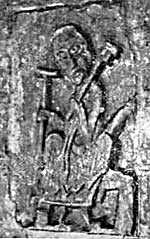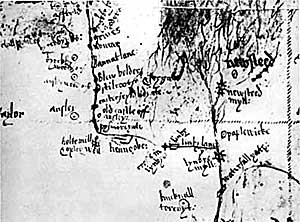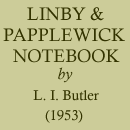< Previous | Contents | Next >
Enclosures

The older carving over Papplewick Church doorway.
During the centuries from the Conquest onwards, and particularly during the XVI century, agricultural conditions were undergoing changes through the various enclosure movements. Graduallv the smaller landholders lost their individual estates, while the enclosure of the commons and the common fields deprived the cottagers of their rights of pasture. This crushed the small man, since few had sufficient tend without the commons to maintain their cows and sheep; and it made him dependent upon the larger estates for his livelihood. The initial idea behind enclosure was quite good, namely for men to consolidate their land into a compact and workable estate, in place of the strip system whereby a man might have small plots of land all over a parish; but it is impossible to justify the selfishness which lay behind so much of the enclosure which took place.
Not all enclosures were for purely utilitarian purposes, and many manor holders enlarged their parks and pleasure grounds at the expense of the little man without influence. In 1304, Edward, King of England, Lord of Ireland, and Duke of Aquitaine, granted to Thomas de la Hay:
Thirty acres by the perch of twenty four feet in the Haye of Lyndeby ... So that the said Thomas and his heirs may enclose the said thirty acres of waste with a ditch and a hedge according to the Assize of the Forest, and may bring them into cultivation . . . With free entry and exit to their cattle of all kinds from the nearest King's highway . . . provided however that the said Thomas and his heirs shall not be able, by reason of the said thirty eight acres to claim to themselves or have any commons outside the same thirty eight acres. (Archives of Newstead). This example is one which gives a certain amount of protection to the cottager.
In 1514 the Chancery Misc: Rolls give another aspect of enclosure, as follows:—
Nicholas Strelley was seised of his demesne as of fee of fifty acres of waste in Lyndeby, and being thereof so seised on the first of September in the sixth year of King Henry VIII, imparked the aforesaid fifty acres or enclosed them with a certain paling and them so enclosed he keeps for rearing wild animals.
Some enclosure of forest land, waste and common also took place for the rearing of the forest sheep whose wool was so valuable to the weaving industry. Papplewick especially seems to have been noted for its sheep, and was the scene of many an important sheep fair in these days. In fact the sheep fair at Papplewick, held on the last Tuesday in August, was reputed to have been more important even than the celebrated Nottingham Fair.
In spite of the development of the railways, and the colliery, both Linby and Papplewick maintain their rural character, and Linby is reputed to be one of the prettiest villages in the county, with its Crosses at either end of the main street, and the roadway flanked with the twin streams.
The Royal Forest of Sherwood

XVI Century Map (part of) of Sherwood Forest, Circa. 1593 A.D.
Since all Papplewick and half Linby lay within the bounds of Sherwood Forest, it is not remarkable to find that forest officials were among the residents, and that Forest Courts were held here. The Forty Days Court, as it was called, was held every six weeks on the same day of the week in the bailiwicks of Linby, Calverton,
Edwinstowe, and Mansfield, on Monday, Wednesday, Thursday, and Friday respectively. The jurisdiction of the court was relatively small, and dealt with offences of trespass of vert: venison and larger trespasses would be dealt with by the Justices in Eyre. Of the forest officials the Regarders were chief, twelve knights being appointed to make a triennial inspection within the metes and bounds of the forest. The Wardens were the custodians of the forest, and were appointed either by Letters Patent under the Great Seal during the King's pleasure, or were hereditary officials who could only be removed from office for treason or some other great crime. Next to them in importance were the Verderers, who were directly responsible to the King. They had to be owners of land within the forest, and their chief work was to attend the forest Courts. The Foresters were appointed by the Wardens, and went either on horse or foot, but theirs might also be a hereditary appointment, being known in that case as Foresters in Fee. Subordinate positions were those of the Woodward, sworn to protect the King's interests as well as those of his master, being appointed by the landowner: the Ranger, whose work lay more within the disafforested purlieus: and the Agister, whose task was to collect the agistment money on the King's property. In the time of King Edward III the Chief Keeper of Sherwood Forest had "In the Hayes of Beskwood Lindeby, and Willey, one Forester riding, with a page, two Foresters on foot, two Verderers, and two Agisters. From 1289 onwards there is frequent mention in the old records of Robert of the Hall of Lyndeby as agister, and also as a juror on the Inquisitions. It is reported that Richard Poe, Chief Forester in the time of James I is buried in Papplewick Porch, but his brother, Anthony Poe of Papplewick, who was his assistant, left a will which is in the custody of the York Register, directing his body to be buried in the South Porch at Papplewick.
The King often exercised his rights in the Royal Forests to make grants of trees for repair purposes, and sometimes as alms. There are many entries in the Close Rolls which illustrate these; as for example in 1207 when a grant was made to the Canons of Newstead of wood for the repair of their mill—Ronable estuviu sine de maeremio ad reparanda molendina sua de novo loco.
In 1231 a grant is made to Lenton Priory of two oaks so that they can repair the refectory roof; while in 1242 the Constable of Nottingham Castle is granted timber with which to conduct sundry repairs at the Castle— Constabulario castri Notingh maeremium in haiis de willegh et Lyndeby ad gisteandum et plancheandum quandam turrim ad capud camere regis ejusdem castri.... Ten years later there is a record of wood being granted for the repair of the Castle mill: De pomeriis et roboribus veteribus quantum necesse fuerit ad perficiendum rotas molendinorum regis ejusdem castri et alia minuta ad molendina illa pertinicia. Again, in 1268 the Close Rolls mention a grant of three oaks for the repair of the West gate of Nottingham: Quod in haia regis de Lindeby que est infra forestam regis de Shirwod faciat habere probis hominibus regis Not' tres quercus ad maeremium ad portam ejusdem ville versus occidentum inde reparandum de dono regis.
Many more examples could be quoted in similar circumstances, so we will conclude with an order given to Robert de Maule to fell and sell all the timber in Lyndebyhagh and use the proceeds to impark Bestwood ....Mandatum est Robto de Maule capital foresta R. de Shirwood qd totum boscum infra boscum R. vocatum Lyndebyhagh infra foresta pdcam psterni et ad opus R. vendi et denar' inde pvmentibus boscum R. de Beskwode. Many other references to the Forest occur in the old documents, from which come the following extracts:
1287. Appointed as foresters under Walter of Winkburn, Attorney of the Justices of the Forest under Robert of Everingham, Forester in Fee, Roger of Lyndeby and Bate of the same town. (Forest Eyre Rolls).
1304. Return of the Ministers of the Forest of the acres delivered in accordance with a grant to the Abbot of Rufford to fell sell or do what he will with forty acres of his wood within Sherwood, also at Wulfcliff was assigned oon acre that containeth IXoo oakes, sold to John de Lyndeby for £9 10s. (Perhaps John le Colyer. i.e. the charcoal-burner).
1344. Presentment of the Verderers in the fifteenth year of King Edward, grandfather of the Lord King who now is, because they did not produce the Rolls of Attachment of ... Lyndeby, for the same year.
1447. In the account of Jeffraye Knyveton, Constable of the Castell of Nottingham and Clarke of the Forest of Shirwood.
Lyndebye is a hole towne for it is of the auncient demne of the crowne. And Laurence of St. Michael holdeth it to the Kinge: and the Kinge hathe XL tie oxgange of lande and of everie oxgange by the yeare IIJ.S IJ.D the some VJ.LI VJ.S VII J.D. Also he hathe there IIIJ cottages and a half wch given to the Kinge by the yeare V.S and he hathe there for half of the mylne demne IIIJ.D. Also he hathe of the Pryour of Newsteade for an assarte called Breadley in the Haye of Lyndebye IIJ.S IIIIJ.D: Also he hathe of the towneship of Lyndebye for herbage alone of the residewe of the Haye of Lyndebye not assarted VJ.S VIIJ.D by the hande of the Sherif to be paid to the Kinge at his exchequer at the tearmes of St. Michaell and pasche by even porciones. Sum total VIJ.L XV.S IIIJ.D. (Forest Book MSS).
1506. John Halley of Linby by force and arms cut down and carried away three oak trees of the price of XXI.D from the King's forest of Shirwode without the King's licence. (Inquisitions).
1530. A commission directed to the Abbot of Welbeck to vewe and certyfye the number and state of the dere within the Forrest of Shyrwood. Papilwike. The number of rede dere theyre LX.XIIJ. Of whyche dere of Auntler XIJ (Inquisitions). Lymbe hawis walke XXX & XX.
Of other points of general interest we may note that John Evelyn in his diary speaks of a castle at Papplewick, but of this the only trace is in one of the field-names, Castle Field; while at Linby, marked on a XIV century man belonging to the Duke of Rutland, is Ye Owte Castel of Linby, lying to the west of the town. This may refer to the castle the site of which is marked on the Ordnance maps, more usually as Annesley Castle, since up to the present no traces of a castle or fortifications have been discovered at Linby.
Families connected with the history, of the parishes include those of Strelley, Hunt, Savage, Stanhope, Savile, Chaworth, Byron, and Montagu; all save Savile and Montagu have in bygone days become related in some degree by marriage.
The chief items of interest within the parish are the two churches, Linby Hall Farm, the two Crosses, and Papplewick Hall.
